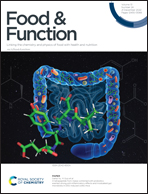Ganoderma lucidum polysaccharide peptide alleviates hyperuricemia by regulating adenosine deaminase and urate transporters
Abstract
Hyperuricemia (HUA) affects human health and is involved in the pathogenesis of common chronic diseases. Previous studies showed that Ganoderma lucidum extract lowered HUA in animals. However, the active ingredient and pharmacological mechanism of Ganoderma lucidum extract in the improvement of HUA are unknown. The purpose of this study was to determine the anti-HUA efficacy and related mechanism of Ganoderma lucidum polysaccharide peptide (GLPP) using a potassium oxonate (PO)-induced mouse model and an adenosine-induced cell model. The experimental results showed that blood uric acid (UA) was decreased up to 40.6% by GLPP in HUA mice in a dose-dependent manner. Additionally, GLPP significantly reduced UA production by inhibiting the hepatic and blood adenosine deaminase (ADA) activity and increased UA excretion by decreasing the expression of glucose transporter 9 (GLUT9) and increasing the expression of organic anion transporter 1 (OAT1) in kidney. The adenosine-induced cell model showed that the inhibitory effect of GLPP on ADA activity may be the main reason for the alleviation of HUA by GLPP. Furthermore, PO-induced renal histopathological damage was also alleviated by GLPP in a dose-dependent manner. The experimental results in this study indicated that GLPP exerted anti-HUA effects via regulating the UA production and excretion, suggesting that GLPP could be developed into a therapeutic agent for HUA.

- This article is part of the themed collection: Food & Function HOT Articles 2022


 Please wait while we load your content...
Please wait while we load your content...